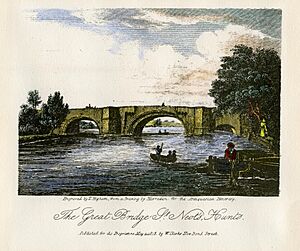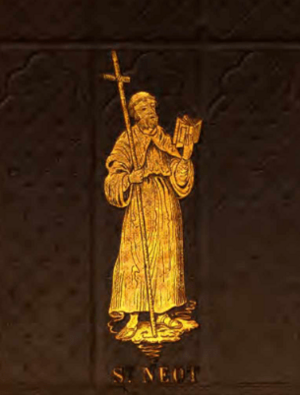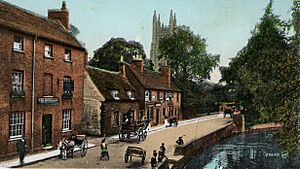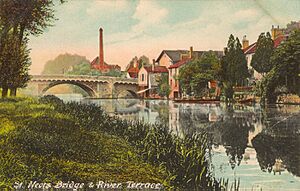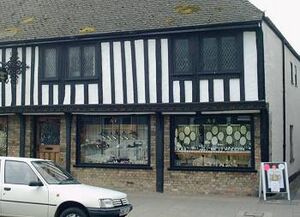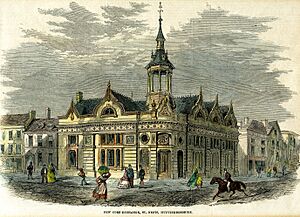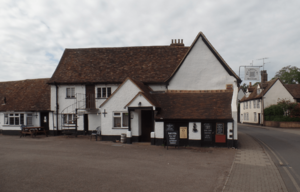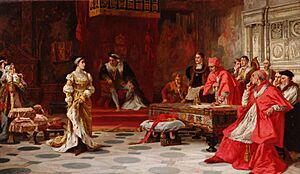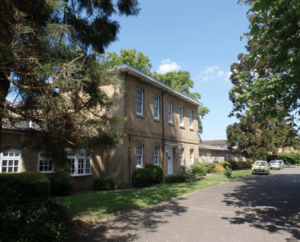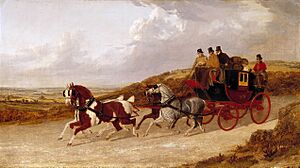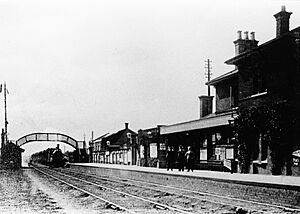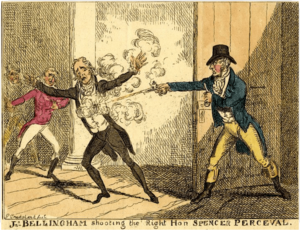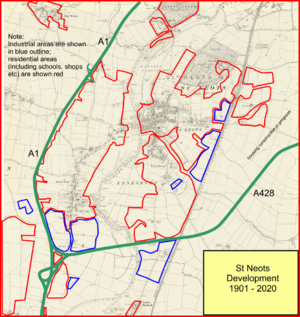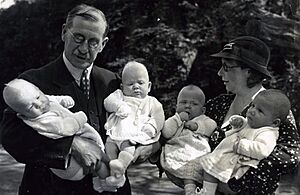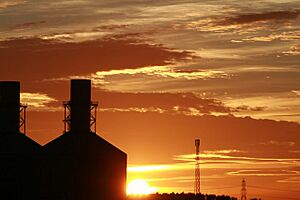History of St Neots facts for kids
St Neots is one of the biggest towns in Cambridgeshire, England. It's located in what was once Huntingdonshire. Long ago, people lived here even before the Romans arrived. During Roman times, a strong settlement was built, especially in the area now called Eynesbury.
Later, around 877 AD, a holy man named Saint Neot died. His bones were kept in a church in Cornwall for about a hundred years. Then, around 974 AD, a special religious house called a Priory was built in Eynesbury. The local landowner brought Saint Neot's bones to this Priory. This made the Eynesbury Priory very famous, and soon that part of the town became known as St Neots.
After the Norman Conquest in 1066, the Priory became linked to a big abbey in Normandy, France, called Bec Abbey. It grew very important until the Dissolution of the Monasteries (when King Henry VIII closed many religious houses). The Priory was destroyed, and Saint Neot's bones were lost.
In the early 1800s, St Neots became very important because of stagecoach travel. Stagecoaches were like old-fashioned buses pulled by horses. Many coaches stopped in Eaton Socon, which was on the Great North Road, to change horses and let passengers rest. Some coaches also passed through St Neots. The River Great Ouse also brought a lot of trade. When the railway opened in 1850, St Neots got a station. This made stagecoach and river travel less popular, and the town's prosperity dipped for a while, but it later recovered.
After 1945, many new houses were built in St Neots. This was part of a plan to move people from crowded areas in London. House building continued over the years and sped up a lot in the 2000s.
In 1965, the areas of Eaton Ford and Eaton Socon became part of St Neots. The old county of Huntingdonshire was changed, and St Neots became part of Cambridgeshire. This history article covers the modern St Neots area, including Eaton Ford, Eaton Socon, and Eynesbury.
Contents
- Early Settlements in St Neots
- Roman Times in St Neots
- Anglo-Saxon and Viking Periods
- The Spread of Christianity
- The Priory and Saint Neot
- Viking Attacks
- Norman Takeover
- Norman Control Strengthens
- Changes at St Neots Priory
- Town Growth and Changes
- Challenges: Wars and Plague
- Old Buildings Still Standing
- Tudor Period (1485 - 1603)
- St Neots Town Bridge
- Stuart and Civil War Period
- Religious Revival
- Lords of the Manor
- Helping the Poor
- Turnpikes and Stagecoaches
- Education in St Neots
- The 1800s
- Prime Minister's Assassination
- Local Government Changes
- Water and Sewerage
- The River in the 1800s and 1900s
- Twentieth Century Wars
- Population Growth
- The 1900s
- Recent History
Early Settlements in St Neots
There were small groups of people living in St Neots, Eynesbury, and Eaton Socon during the Neolithic period (Stone Age), which ended around 1,700 BC. More signs of settlement have been found from the Bronze Age (starting around 1,700 BC). These include an axe head and clues of a large building, possibly a temple, in Eaton Ford. Polished stone axes and special pottery called beaker pottery have been found in Eynesbury.
Archaeologists found remains of Bronze Age fields from about 1,500 BC where the Love's Farm houses are now. A farming community lived there for over 700 years, from about 200 BC to the 5th or 6th centuries AD. From the Iron Age through the Roman and early Saxon times, people kept living on this land. They improved drainage, grew new crops, raised animals, and built enclosures, roads, and monuments.
There's also proof of Iron Age settlements. A pit with pottery was found at what is now Ernulf Academy. People from the later Iron Age also settled near Howitts Lane. All this early activity changed the natural landscape quite a bit, mostly by cutting down trees to clear fields and build homes.
Roman Times in St Neots
During the Roman period (43-410 AD), the Eynesbury settlement grew towards the River Great Ouse. It was built on higher ground to avoid floods. A large Roman camp was located in the Conygeare area of Eynesbury.
Archaeologists have found at least two houses in this area that had hypocaust central heating. This was a clever Roman system that used hot air under the floors. It's possible that farm products were loaded onto boats here to be sent down the river. This food might have gone to supply the Roman army further north.
Eynesbury also had good Roman roads. A road from Sandy to Godmanchester passed nearby, with a branch leading to Eynesbury. You can still see its path on modern maps. A footpath today, from Duck Lane towards Wintringham, follows the line of an old Roman paved path, and Roman pottery has been found near it.
Anglo-Saxon and Viking Periods
The Romans left Britain between 446 AD and 454 AD. New people, mainly the Angles and Saxons, then arrived. They took over or pushed out the local people and set up a system of local government. The area was divided into "hundreds," which might have been areas with about a hundred families. The land east of the River Great Ouse belonged to Toseland Hundred, and the western area to Barford Hundred.
A Saxon leader named Ernulf (or Eynulf) took over the Roman camp near the river crossing at Coneygeare. This area became known as Eanulfsbyrig, meaning "Ernulf's fort." Later, it changed to Einulfesberie, and then Eynesbury. St Neots didn't exist as a separate place yet; it was just part of Eynesbury.
West of the river, an Anglo-Saxon leader took control of a village near the water, probably opposite Coneygeare. This was called Ea-tun, meaning "waterside-village." Another settlement a bit further north was called Forda, and later just Ford. A smaller settlement was on the hilltop near the Duloe windmill, and it was called Sudbury, meaning "the southern fort."
Everyday items have been found from this time, like clay weights for weaving, broken pottery, grinding stones, a plough share, and an iron axe. Burials from this period contained other objects like swords, spears, pagan brooches, and knives.
During this time, the River Great Ouse was much wider and shallower than it is today, with banks that weren't clearly defined. This meant people could cross the river by walking through it (forging), especially during drier times.
The Spread of Christianity
Even though Christianity was practiced during Roman times, most people were pagan (worshipping many gods). The Pope didn't like this, so in 597 AD, he sent Augustine to help convert the people back to Christianity. Augustine's efforts, along with missions from other areas, were successful. A hundred years later, most of East Anglia was Christian.
A main church was built in Eaton to serve a large area on the west bank of the Great Ouse. On the east bank, at Great Paxton, another church served an area that included present-day St Neots and Eynesbury. Later, in Saxon times, Eynesbury built its own church.
The Priory and Saint Neot
Around 972 AD, an Anglo-Saxon landowner named Leofric and his wife Leoflaed started a small monastery (a place where monks live) in Eynesbury. This settlement was at the meeting point of Huntingdon Street and Cambridge Street. However, Leofric and Leoflaed built their priory closer to the river, near what is now Priory Lane, St Neots.
Priories could earn a lot of money from pilgrims visiting and donating. To attract pilgrims, they needed special holy objects, called relics. Leofric decided to get the bones of Saint Neot, a respected Saxon monk who had lived much of his life in Cornwall. Saint Neot had died around 875 AD and was buried there. The village in Cornwall is still called Saint Neot. Leofric arranged to take Neot's bones and bring them to his Priory. This worked, and the Priory became a very popular place for pilgrims.
According to historical records, the area near the Priory was renamed Neotsbury around 974 AD.
Viking Attacks
In the late 900s and early 1000s, Viking raiders from Denmark began to take over areas away from the coast. They rowed their longboats up the River Great Ouse, attacking religious houses to steal their treasures. As pagans, they had no problem with this. It's likely that the Priory was destroyed by the Danes around 1010 AD. To keep Saint Neot's bones safe, they had been sent to Crowland Abbey in Lincolnshire. Neot's remains were brought back to the Priory in Eynesbury in 1020.
Norman Takeover
In 1066 AD, William, Duke of Normandy, invaded southern England and defeated the English forces at the Battle of Hastings. This takeover of the Anglo-Saxon people is called the Norman Conquest. The Normans found that the people they conquered were a mix of Celts, Angles, Saxons, and Danes.
In Eaton, on the west side of the river, the local leader was Ulmar, a thegn (a type of noble). He was in charge of two sokemen. A "soke" was a smaller area of land and control. Over time, this area became known as Soka de Eton by 1247 AD. In 1645, it was called Eton cum Soca, and in the 1800s, it became Eaton Socon.
The manor (a large estate) of Eaton had two water mills, a church, and a priest. There were 38 villein families (farmers who worked for the lord), seven smallholders, and eight tied laborers.
On the east side of the river, Eynesbury had two manors. The southern manor was about the same size as Eaton, with about 42 houses and a church. These villagers raised sheep instead of pigs (like in Eaton) and also had watermills. The northern community had about 25 houses and had rights to fish in the river, as well as a mill. It also had the Priory with Saint Neot's relics, which brought it great importance and income.
Norman Control Strengthens
William the Conqueror became King William I and built forts to control the local areas. One was at Huntingdon, controlling the area east of the River Great Ouse, and another at Bedford, controlling lands to the west. The local leader was called a baron, and the area was a barony. Manors, which were local centers for farming and leadership, were given to favored Norman individuals.
The northern manor of Eynesbury, which is roughly modern St Neots, was owned by Richard fitz Gilbert and his wife Rohese Giffard. Richard owned many lands elsewhere, so Rohaïs might have been in charge at Eynesbury. This manor included the Priory.
The southern manor at Eynesbury, located within present-day Eynesbury, was owned by a Saxon noble, Earl Waltheof. He had married Judith, who was King William's niece. In 1075, Waltheof was involved in a rebellion against the King and was executed. Judith then became Countess of the manor.
At Eaton, the manor was first given to Lisois de Moutiers. But by the time of the Domesday Book in 1086 (a great survey of England), it had been given to Eudo Dapifer. He was an important steward in the Royal household, which brought prestige to Eaton.
Changes at St Neots Priory
By the late 1000s, the Priory's fame because of Saint Neot's remains led to the area north of the Hen Brook being called St Neots. This name is used for the rest of this article.
The Priory's importance was greater than the farming value of the St Neots manor. After 1078, it became linked to the important Abbey of Bec in Normandy, France. Lanfranc, who used to be the head of Bec Abbey, became Archbishop of Canterbury in 1070. Anselm followed Lanfranc as head of Bec and became its Abbot in 1078. He was very interested in the St Neots Priory, seeing it as a way to spread Benedictine influence. He made it the most important possession of Bec in England. About 18 monks were moved from Normandy. Anselm visited St Neots a few years later to check if the relics were truly Saint Neot's bones. He seemed satisfied. When he returned to Normandy, he took the Saint's jawbone with him.
The rebuilding of the Priory was finished by 1110. Richard of Clare had died, so Rohaïs was now in charge of the entire manor. She gave it to the Priory and its monks at a special ceremony in 1113. The building included a church with a bell tower, a dining hall (refectory), a sleeping area (dormitory), a meeting room (chapter house), and a central courtyard (cloister). There were also kitchens, a storage cellar for food, and other buildings like stables, barns, workshops, and pigsties. Foundations and parts of columns have been found, along with glazed floor tiles, painted wall plaster, pieces of stained glass, and carved stone. By this time, the Priory was very large, stretching from the river almost to New Street, and from the Common to the market square.
While St Neots was growing, a small religious house was started in Eaton Socon in the 1100s. William of Colmworth and some monks were given land at Bushmead by Hugh de Beauchamp around 1195. After 1215, it became an Augustinian priory, but it was never as famous as the St Neots Priory.
Town Growth and Changes
Around 1130, St Neots was allowed to hold a weekly market on Thursdays and four fairs each year. The St Neots market is thought to be one of the first "new towns" or "plantation" markets. This brought more money to the Priory. The market was held very close to today's market square, just south of the Priory.
Later, in 1180, a wooden bridge was built where the current bridge stands. The Priory collected tolls (fees) for crossing it. There had been river crossings before, probably places to walk through the river (fords) or ferries, at Coneygeare and Crosshall, but these were used less now. The Crosshall ford was further north than the current bridge. Crosshall Road might have been built to go straight to the Priory and the ford. The market and the pilgrims visiting Saint Neot's relics encouraged permanent shops. By 1180, St Neots was allowed to become its own parish, separate from Eynesbury. The name St Neots, which had been used informally, was now official.
Hugh de Beauchamp built a castle in what is now Eaton Socon around 1140. It was probably made of timber with earth mounds and might not have been fully finished. However, the earth mound still exists. The castle was built during a civil war over who would be king. Matilda was the heir to King Henry I, but some powerful nobles supported Stephen. In the civil war that followed, several forts were quickly built to support Stephen, and Eaton Socon Castle was one of them. Stephen's supporters won, and he became king. When he died in 1154, Matilda's son Henry became King Henry II. One of his first actions was to order these castles to be torn down.
Some living quarters must have remained, and Lady Juliana de Beauchamp lived there in the 1200s. Even though it was torn down, the castle and the remaining buildings gave Eaton a lot of importance.
Around 1204, a new parish church was built in St Neots. You can still find parts of it in the 15th-century church that stands there today. St Neots became a separate parish from Eynesbury in 1204. Both Eynesbury and Eaton Socon parish churches were rebuilt around the same time. The North Arcade in Eynesbury church is probably the oldest part remaining from this period. The Priory became very respected and rich during this time, and the towns of Eynesbury, St Neots, and Eaton Socon also did well. More river and road traffic made the three communities even more important, and they all thrived.
Throughout the 1100s and 1200s, the importance of the area and the Priory, along with the trade benefits of the main roads passing through, increased the towns' importance. In 1156, King Henry II visited, staying at the Priory with many people. King Henry III also visited the priory, staying there in 1229, 1235, and 1236.
Challenges: Wars and Plague
The Priory and the town faced two big problems in the 1300s. The Hundred Years' War (1337 - 1453) was a long and difficult conflict between England and France. Because the Priory was linked to the French Abbey of Bec, it was seen with suspicion as a foreign outpost. This greatly reduced its income from pilgrims and led to financial penalties. In 1409, the Priory was given its independence from Bec, which slowly allowed it to regain some prosperity.
However, historical records also suggest that the Priory was declared independent because religious services were being neglected and money was being mismanaged. An English leader was put in charge.
In 1348, the Black Death (a terrible plague) broke out. It killed about a third of the population and made people very afraid to travel. Pilgrimages to the Priory became unsafe. Besides widespread devastation, it's believed the plague wiped out the village of Sudbury, which was located at the junction of Crosshall Road and the Great North Road.
Old Buildings Still Standing
Very few regular buildings from the 1400s have survived. A beautiful timber-framed building from the 1400s has been found at the corner of Church Walk in St Neots. It's thought to have been built for a rich corn merchant. From the same time is the Old Falcon on the Market Square. Its current front hides a much older inside. Eynesbury's oldest surviving medieval building is The Chequers in St Mary's Street. Although it's roughly dated to the early 1500s, it was probably there a century earlier.
Tudor Period (1485 - 1603)
Henry VIII became King of England in 1509. When he broke away from the Roman Catholic Church, he started the Dissolution of the Monasteries. This meant he closed down and destroyed most of the country's monasteries. St Neots Priory was closed in 1534, and the remaining 12 monks were given pensions. Many buildings, land, and valuable items were taken and sold or given to the King's friends. Sadly, there's no record of what happened to Saint Neot's bones. Eight years later, the buildings and land were sold, while the manor was given to the King's daughter Elizabeth, who later became Queen Elizabeth I. A brewery was built on the Priory site in Victorian times.
In 1591, 879 people lived in Eaton Socon. Since Eynesbury and St Neots were probably similar in size, this suggests a total population of at least 2,000. St Neots Grammar School existed by 1556.
St Neots Town Bridge
The first bridge across the River Great Ouse at St Neots was likely built in the 1000s or 1100s. Its purpose was to bring traders and pilgrims to the market started by the monks of St Neots Priory. It probably replaced a ford (a shallow place to cross the river). It was made entirely of wood and included a long raised path because there were marshy areas on both sides of the river.
In 1588, a new town bridge was built. A survey of the old bridge showed it had 72 arches and was 704 feet long and 7 feet 6 inches wide. The new bridge was planned to have stone supports up to the flood level. The river was the boundary between Bedfordshire and Huntingdonshire, so both counties had to help pay for the materials and labor.
The town bridge was replaced again, probably in 1617, but this time entirely with stone. The bridge was very important because it allowed river traffic to pass easily and helped trade grow. Other improvements in the same period included work on the river to make it easier for boats to travel. In 1670, a law was passed to improve the River Ouse, allowing boats to go as far as Bedford.
During the 1800s, the top part of the bridge was made wider. The special "scallops" (curved parts) that were unique to the Huntingdonshire half were added along the whole length. These scallops were actually jack-arches supported by beams, which helped extend the walkway. The end of the bridge at Eaton Ford was also widened to reduce traffic jams.
The old stone bridge lasted well into the 1900s. However, it wasn't strong enough for modern motor traffic, even when only one-way traffic was allowed. There was a speed limit of five miles per hour. Because it was on a county boundary, talks about replacing it took over 20 years. Finally, in 1964, the "pretty but weak structure was torn down, and work began on the current, more practical bridge."
Stuart and Civil War Period
The St Neots Manor, which was once owned by the king, passed to Sir Sidney Montague during the reign of King James I. In the First Civil War, Sir Sidney supported the Royalist (or Cavalier) side, who were loyal to the King. However, his nephew, Edward, supported Parliament. Like in many parts of the country, people had mixed loyalties, but St Neots was firmly controlled by Parliamentary forces, and a group of their soldiers (called Roundheads) guarded the town. Despite this, King Charles I passed through the town in 1645 and found local people willing to join his army.
On July 10, 1648, during the Second Civil War, a small battle happened in St Neots. A group of 300 Royalists camped overnight in the Market Square. They were surprised and defeated by a smaller group of Roundheads who advanced across the bridge. Most of the Royalists were captured.
From 1653, there was a period called The Protectorate, when Parliament ruled the country under Oliver Cromwell. During this time, many religious decorations were destroyed because they offended the strict beliefs of the Puritans. After seven years, the monarchy was restored under King Charles II.
Things slowly returned to normal. Many buildings in St Neots and Eynesbury were built in the years after the monarchy was restored. In 1674, records for the Hearth Tax (a tax on fireplaces) showed there were 543 houses in the town. The Waggon and Horses pub in Eynesbury and Ford House in Eaton Ford date from this period. On the other hand, Eynesbury Church was allowed to fall into disrepair until its spire collapsed in 1684, causing a lot of damage. The building was repaired, and the current tower was built in 1687.
Religious Revival
The first non-Church of England chapel in the area was built at Hail Weston. A Congregational church Meeting House was set up on the north side of St Neots High Street in 1718. This chapel was made bigger in 1889 for more people. Meanwhile, Baptists, who separated from the Congregationalists in 1800, built a chapel in New Street. Methodism started in St Neots after John Wesley visited in 1772, and the first Methodist chapel was built in 1794. Other chapels built during this time include the Salvation Army building in 1891, and chapels in New Street and East Street, which are now used by the Roman Catholic Church. In 1883, the Salvationists were criticized by local officials for "showing their religious views to the public in a showy way." By the time of the 1851 Census, there were as many Non-Conformists (Protestants not part of the Church of England) worshipping on Sundays as there were members of the Church of England.
It was a time of religious growth, not just with new churches but also with the revival of the main parish church. In 1847, for over £2,000, the church floor was replaced, pews were renewed, and much of the stonework was repaired. Beautiful stained-glass windows were added between 1859 and 1902, mostly paid for by C P Rowley. A new organ was installed in 1855.
In 1863, the Corn Exchange was built at the corner of High Street and South Street. It was meant to be an indoor market for farmers, but it also hosted concerts and meetings. After 1887, it even had a museum. Other facilities included the Library and Literary Institute, founded in 1881, the Liberal Club, and the Constitutional Club, founded in 1895. There was a Workmen's Club at Eaton Socon from 1880, meeting in the school, and a Reading Room was set up in the Eynesbury school in 1868.
Lords of the Manor
The Rowley family became the Lords of the Manor (the main landowners) in 1902. However, the Rowleys first appeared in the 1700s at Upper Wintringham when they bought a house. Then, in 1793, Owsley Rowley bought Priory Farm from his father-in-law. He started turning the farm into parkland – it was 1,263 acres – and in 1798, he built a large house on it. Rowley bought a lot of land, making him probably the most powerful man in town, long before his family became Lords of the Manor. He was a Justice of the peace (a local judge) and led the local court for 25 years.
When he died in 1824, his son George William Rowley took over. Owsley Rowley's third grandson, Charles Perceval Rowley, who lived at Wintringham, paid for ten of the stained-glass windows in St Neots Parish church. The second son, George Dawson Rowley, became famous as an explorer and bird expert. Some of his collection of stuffed birds is now in the British Museum. He and his father died within hours of each other in 1878, and his only son George Fydell Rowley took over.
Helping the Poor
As society changed with new farming methods and early factories, it became clear that an organized way to help very poor people was needed. St Neots and Eaton Socon had local workhouses since 1722 and 1719, respectively. This was called "indoor relief," where poor people were given a place to live and food instead of money, and were made to work if they could. The Workhouse system was introduced across the country after the Poor Law Amendment Act 1834.
This led to the creation of the St Neots Poor Law Union on September 24, 1835. After some difficulty finding a good location, a workhouse was built in Eaton Socon (now considered part of Eaton Ford). It could hold 250 people. A separate hospital building was ready in 1879, increasing the workhouse's limited capacity.
The workhouse stopped being a workhouse in the late 1920s. The building was then used as a hospital for older people and was renamed the White House. In the 1950s, part of the back of the building was turned into flats, and in the 1980s, the entire building was greatly changed and became residential flats.
Turnpikes and Stagecoaches
In the 1700s, new ideas and ways of life began to grow, and things sped up. The roads, which were fine for people who didn't travel much in the 1500s, were now slowing down trade. Local people were responsible for road upkeep, but it wasn't fair for rural people to pay for roads connecting big towns. While stagecoaches are exciting, slow goods carts also made up a lot of traffic.
By 1700, a few turnpikes had been set up. A turnpike was a toll road: the money collected from tolls was used to maintain the road surface. Eventually, special laws were passed to allow Turnpike Trusts to manage parts of roads. In 1725, a Trust was created to manage the Great North Road between Biggleswade and Alconbury. Another was founded in 1772 to manage part of the road between Cambridge and St Neots.
Better roads meant more travel, and the number of coaches and carriages passing through St Neots and Eaton Socon increased. Road travel was at its peak in the 1700s, especially with the introduction of the stagecoach. Teams of horses were changed every 10 or 12 miles, at "stages," allowing the coach to keep going, stopping only for the change and for meal breaks. Coaching inns along the route arranged for the horses to be fed and rested, and had fresh horses ready for the next part of the journey. Overnight stays were provided, as long trips took several days. Feeding the horses was the biggest cost for the coach operators.
By 1754, coaches were traveling from London as far as Edinburgh (taking 8 or 9 days). At the busiest time for stagecoaches, 20 coaches passed through Eaton Socon daily. Some went straight up the Great North Road after changing horses at The White Horse, and others took the loop through St Neots. At The Cross Keys Inn, mail was collected, as well as passengers.
At this time, stagecoach travel was at its busiest. Some coaches went into St Neots, and some passed through Eaton Socon. The two routes met again at Alconbury Hill. The stretch from there to Norman Cross was the busiest road in England. Stagecoaches passed along this section every 20 minutes, day and night. The Bell Inn at Stilton, where horses were changed, had stables for over 300 horses.
Education in St Neots
In 1736, a school for 35 "poor boys" was started in St Neots. By the end of the century, there was a school for poor children, and both boys and girls were taught. Classes were first held in the Jesus Chapel of St Neots Church, but after 1745, they moved elsewhere. In 1760, Alderman Newton left money in his will to help schools in Huntingdonshire, and the St Neots school received £26 to clothe and educate poor boys.
The Huntingdonshire Education Committee resisted providing a secondary school in St Neots for a long time. In 1926, about a hundred students traveled to Huntingdon every day for school. After the Education Act 1944 was passed, grammar schools were set up. Local politicians in St Neots asked for one, but it was said there weren't enough grammar school students in St Neots to justify it. At this time, Eaton Socon was in Bedfordshire, so some St Neots students traveled daily to Huntingdon, and some Eaton Socon students traveled daily to Biggleswade.
It wasn't until 1960 that a secondary school was established in St Neots. Eaton Socon was still in Bedfordshire, which made things complicated. St Neots grammar school students still had to travel daily to Huntingdon. Full secondary education was finally provided in St Neots with the establishment of Longsands and Ernulf comprehensive schools in 1966 and 1971.
The 1800s
New Industries
The oldest types of industry grew from farming needs. Corn was milled at Duloe using a windmill and at Eaton Socon using water power. A malt mill was started in 1604. Real industrialization began in St Neots, like elsewhere, in the 1700s. St Neots' most important contribution was in paper making. In 1808, Sealy and Henry Fourdrinier invented a process to make paper in a continuous roll. This process was first used at St Neots Mill (in Little Paxton). The machines were powered by water, but later steam engines were used.
Despite their invention's success, the Fourdrinier brothers faced financial problems. Their business was taken over by Matthew Towgood. Towgood and his sons ran the mill until the early 1880s, when the St Neots Paper Mill Company took over.
A bell foundry (a place where bells are made) was started in 1735 by Joseph Eayre. The foundry was in a cone-shaped building later called the 'Oast House' within the Brewery grounds. Eayre's business was continued by Edward Arnold and then Robert Taylor. Taylor had to leave the brewery site near the end of the century. For about two decades, he cast bells in the Cambridge Street area before moving to Oxford around 1820. The family business later moved again to Loughborough, where it continues today – in 2020, it was the last bell foundry left in England.
Brewing became more industrial in the 1700s. James Paine bought William Foster's brewery in the Market Square in 1831. The Priory Brewery, on the site of the old Priory, was owned by the Fowler family and sold to John Day of Bedford in 1814. John Day also provided St Neots with its first street lamps.
In 1820, Gorham wrote that: "The river Ouse can be used by boats from the port of Lynn to St. Neot's, and from there to Bedford. A lot of trade happens with corn, wine, coal, iron, timber, and more. The river is usually about 150 feet wide. Most of the town is a few feet above the river's normal level, but sometimes sudden thaws or very heavy rains cause floods so bad that you can travel through the streets by boat."
St. Neots also became famous for making gas appliances. George Bower (born 1826 or 1827, died 1911) built a factory for making gas fires, light fittings, and gas cookers. His business was successful for many years. At its peak, his factory employed 200 workers. However, a major buyer in South America failed to pay, and Bower went bankrupt.
The Arrival of Railways
On August 7, 1850, a railway line opened to the public through St Neots. The Great Northern Railway opened its line from a temporary station in London to Peterborough. In the following years, the company opened lines all the way from Kings Cross to Doncaster, and with other friendly railway companies, reached York and Edinburgh, as well as much of Yorkshire, and later the Nottinghamshire coalfields and the east coast ports.
In St Neots, the railway route was planned to be well east of the town. This was done to avoid taking land from Priory Park, which belonged to George William Rowley. The eastward path made the station's location a bit awkward. Early railway plans were often reviewed by Parliament, and at this time, the Lords Committee often favored landowners. Long arguments in Committee would cost a lot of money that the railway companies didn't have. Rowley had tried to force the railway company to build the line west of St Neots, far from his estate, but Parliament refused. The railway's compromise route was approved. This still took some land from Rowley's property, which the railway valued at £8,000. Rowley demanded £12,000, which he later increased to £15,000. The issue had to be decided by a jury trial. The jury valued the land at £8,000, exactly what the railway company had offered.
The railway quickly replaced stagecoaches. Besides long-distance trains that cut travel time to Scotland to less than a day, there were soon trips to holiday resorts like Skegness and Cromer, and also to London. However, the biggest impact of the railway in the 1800s was transporting goods and minerals: manufactured goods going out, and heavy items coming in, like coal, lime for improving soil, and cattle feed. Coal, especially: the price of coal often dropped by 80% the day after a town got a railway connection.
Unfortunately for St Neots, the rise of railways led to the end of the stagecoach trade, which had brought so much prosperity to the area. Long-distance stagecoach travel quickly disappeared, and river traffic also declined sharply. Merchants and farmers in Bedford and St Neots no longer needed river transport for their materials. Jobs related to stagecoach travel and water transport collapsed. Toll income on the Upper Ouse was £7,656 in 1842 but fell to £4,508 in 1815. From 1852 to 1863, it averaged £1,974 per year.
Nevertheless, St Neots revived its industry and trade. Returning prosperity was clear when the Corn Exchange opened in 1863, and a livestock market opened in the 1890s.
Prime Minister's Assassination
On May 11, 1812, John Bellingham shot and killed the Prime Minister, Spencer Perceval. Bellingham was born in St Neots and had traveled widely for business. He seems to have been cheated and imprisoned in Russia. When he returned, the British Government didn't help him. Holding extreme anger, he carried out the assassination. He was immediately caught and executed a week later.
Local Government Changes
The creation of Poor Law Unions and, from 1877, a national prison system, reduced the role of local judges (Justices of the Peace). Elected County Councils were introduced in 1888.
In the early 1960s, serious plans were made to reorganize local government areas. As it seemed likely that Huntingdonshire would be dissolved, some people repeatedly said that St Neots would prefer to join Bedfordshire rather than Cambridgeshire, as the town felt it had little in common with the "fen towns" (towns in marshy areas). A counter-argument was that Bedfordshire had done little to improve Eaton Socon, while Huntingdonshire had done much to improve St Neots.
On April 1, 1965, Huntingdonshire was combined with the Soke of Peterborough to form a larger county. At the same time, the urban area of Eaton Socon became part of St Neots Urban District. In 1974, Huntingdonshire and the Soke of Peterborough were finally merged with Cambridgeshire and the Isle of Ely. The entire new county was called Cambridgeshire. The Huntingdonshire County Council therefore disappeared in 1974 and was replaced by the Huntingdon District Council, which works within the larger county of Cambridgeshire. The boundaries of the HDC were very similar to those of the former county of Huntingdonshire, with the addition of the Eatons. Huntingdon District Council has now changed its name to the Huntingdonshire District Council. In 1973, St Neots was given the power to create St Neots Town Council, to keep some of the powers of the former St Neots Urban District Council, which was now abolished.
Water and Sewerage
In May 1885, members of the St Neots Local Board met with a government inspector to discuss sanitation in the town. The inspector pointed out many cottages that were crammed into yards and courts behind other buildings. For example, he found "Day's Court" to be poorly paved, very run-down, with no windows in the bedrooms except into the court, and with "foul privy pits" (outdoor toilets) in the court. New buildings were not much better.
In 1898, the St Neots Water Company was formed. Pipes carried water to some houses, and a septic tank system handled some sewage disposal. In 1907, the local authority, by then the Urban District Council, took over sanitation services. However, this was still not a complete solution to all the town's problems. There was still a lot of open-drain sewerage, and wells were also used in many homes. In 1914, only 250 "better class" homes were connected to the main sewer. 800 houses used pail privies (buckets for waste) and even a few earth closets. Water was supplied to five hundred customers, but wells were used elsewhere. Twice as much money was spent on cleaning up waste as on sewerage in 1915. As late as 1931, 700 out of 1,250 homes still didn't have proper sanitation. It wasn't until 1936 that St Neots finally got a sewage treatment plant.
The River in the 1800s and 1900s
The river had been a major transport route before the railways. Navigation Wharf and Hen Brook were busy with barges bringing goods into town. Many more barges traveled from King's Lynn to Bedford, or onto the River Ivel for Biggleswade and Shefford. After the railway arrived in St Neots in 1850, the use of the river for heavy goods transport dropped sharply. The Ivel closed to commercial traffic in 1876, and by 1878, no barges went further upriver than St Neots. By 1890, they only went as far as St Ives. The river began to fill with silt and weeds. The owner of the navigation rights was John Kirkham. In 1892, he tried to sell the rights, but no one wanted them at first. Then Leonard Taylor Simpson bought the rights in February 1893 for £6,170. He spent a lot on improving locks and river maintenance, but the low toll charges, set by law in the 1600s, made it impossible to make a profit. He lost a lot of money.
In September 1897, Simpson realized his task was impossible, and he closed the navigation, physically locking the gates to make them impassable. A lawsuit was started, arguing that he had an obligation to maintain the river navigation and to limit his toll charges to the original level. Appeals and counter-appeals followed, but in 1904, the House of Lords (a high court) ruled in his favor, allowing him to close the navigation. He did so in August 1904.
The Great Ouse Catchment Board bought the navigation from him in 1934, even though it was worth very little.
The first settlements in the St Neots area were built away from areas that might flood. As the population grew in medieval times, construction took place in vulnerable areas, leading to houses being flooded. Efforts were made to control the water, but flooding still happened if the defenses were overwhelmed. The worst floods in the 1900s were in 1908, 1916/17, 1933/34, and the great flood of 1947.
Twentieth Century Wars
World War I
World War I started on August 4, 1914. Towards the end of that month, the local Council was told by the Military Authorities that soldiers would be stationed in the town. The town's water supply needed to be extended to the areas where men and horses would be camped. The Gun Park (now the site of the Priory Infants School) was made available for the troops. However, it was soon realized that the army's heavy equipment needed a stronger, less muddy base. So, from December 1915, all artillery and heavy wagons were kept on the Market Square.
The Highland Brigade Royal Field Artillery was stationed at St Neots from August 1914 to April 1915, before being sent to France.
World War II
St Neots did not suffer any major bombing attacks in World War II. However, the many RAF (Royal Air Force) stations nearby meant that enemy bombers sometimes paid attention to the area. An important issue was taking in evacuated children. The basic services were so primitive that as war became certain, it was urged that trenches should be dug to deal with extra human waste. Three hundred children arrived two days before war was declared; they were all housed in homes in Eynesbury. Well over 1,000 children were housed in 1940.
Population Growth
During the stagecoach era, Eaton Socon had a similar population to St Neots:
| Census year | St Neots | Eaton Socon | Eynesbury |
|---|---|---|---|
| 1801 | 1752 | 1625 | 575 |
| 1851 | 3157 | 2802 | 1233 |
| 1901 | 2789 | 2080 | 1091 |
| 1951 | 4700 | 3032 |
Eynesbury had become part of St Neots by the time of the 1951 census.
The Town Development Act of 1952 aimed to reduce overcrowding in London. This led to the rapid growth of towns like Huntingdon, St Ives, and St Neots in recent years. The population of St Neots had risen to 21,660 by 1982.
The 1900s
The St Neots Quads
In 1935, quadruplets (four babies born at the same time) were born in St Neots to Mrs Doris Miles. This caused a big media stir because they were the first British quadruplets to survive more than a few days. Their early care was carefully managed, largely by the family doctor, Dr E H Harrisson, who made special arrangements for them. They were featured in many newspaper and newsreel reports as they grew up. They are all still alive today (May 2021).
Little Barford Power Station
Little Barford A Power Station started operating in 1941. It could produce 126 megawatts of power. It burned powdered coal, delivered by rail from the nearby main line. Cooling water was taken from the River Ouse nearby, and also from a cooling tower. Little Barford B Power Station, nearby, started operating in 1959 with 127 megawatts capacity. It also used powdered coal and had cooling towers. Both stations were shut down and taken apart in 1989.
A gas-fired power station was built on the same site and started operating in 1996. It is a Combined cycle power plant and can produce 256 megawatts of electricity.
Loss of Industry and Revival
By the late 1900s, many industries in Britain were closing down, and St Neots was affected. Companies like Courtaulds, Samuel Jones, and Gates' Hydraulics closed, and Paine's Brewery was sold and shut down. However, the growth in housing also brought new light and medium-sized industries to the town in modern industrial areas.
Unemployment rates in Huntingdonshire are lower than the national average: 2.7% compared with an average for England of 4.1%. Full-time workers in Huntingdonshire earned a median weekly salary of £600 in 2018, compared to £575 across England.
Recent History
St Neots has been planned for a lot of new housing development in the 2000s. Besides filling in existing spaces, this included the Loves Farm development in 2006. That development is currently (2021) being extended eastward. The first part of the Wintringham Estate, between Cambridge Street and the St Neots bypass, has also been built.



